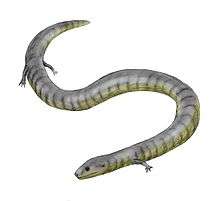Gymnophiona
| Gymnophionans Temporal range: Early Jurassic – Present,[1] 199.6–0 Ma | |
|---|---|
 | |
| Eocaecilia, the earliest known stem-caecilian | |
| Scientific classification | |
| Kingdom: | Animalia |
| Phylum: | Chordata |
| Class: | Amphibia |
| Subclass: | Lissamphibia |
| Clade: | Gymnophiona Rafinesque, 1814 |
| Subgroups | |
Gymnophiona is a group of amphibians which includes the legless caecilians and all amphibians more closely related to them than to frogs or salamanders (the "stem-caecilians").[2] The name derives from the Greek words γυμνος (gymnos, naked) and οφις (ophis, snake), as the caecilians were originally thought to be related to snakes.
Evolution
Little is known of the evolutionary history of the caecilian lineage, which have left a sparse fossil record. The first fossil belonging to this group, a vertebra dated to the Paleocene, was not discovered until 1972.[3] The putative earliest fossil known comes from the Jurassic period; its primitive genus, Eocaecilia, had small limbs and well-developed eyes.[4]
In their 2008 description of the fossil batrachian Gerobatrachus,[5] Anderson and co-authors suggested that caecilians arose from the Lepospondyl group of ancestral tetrapods, and may be more closely related to amniotes than to frogs and salamanders, which arose from Temnospondyl ancestors. Numerous groups of lepospondyls evolved reduced limbs, elongated bodies, and burrowing behaviors, and morphological studies on Permian and Carboniferous lepospondyls have placed the early caecilian (Eocaecilia) among these groups.[6] Divergent origins of caecilians and other extant amphibians may help explain the slight discrepancy between fossil dates for the origins of modern amphibia, which suggest Permian origins, and the earlier dates, in the Carboniferous, predicted by some molecular clock studies of DNA sequences. Most morphological and molecular studies of extant amphibians, however, support monophyly for caecilians, frogs, and salamanders, and the most recent molecular study based on multi-locus data suggest a Late Carboniferous–Early Permian origin of extant amphibians.[7]
Relationships
The most recent phylogeny of caecilians is based on molecular mitogenomic evidence examined by San Mauro et al. (2014).[8]
| Gymnophiona |
| ||||||||||||||||||||||||||||||||||||||||||||||||||||||||||||||||||
| |
References
Specific references:
- ↑ Nussbaum, Ronald A. (1998). Cogger, H.G. & Zweifel, R.G., ed. Encyclopedia of Reptiles and Amphibians. San Diego: Academic Press. pp. 52–59. ISBN 0-12-178560-2.
- ↑ Evans, Susan E.; Sigogneau-Russell, Denise (2001). "A stem-group caecilian (Lissamphibia: Gymnophiona) from the Lower Cretaceous of North Africa". Palaeontology 44 (2): 259. doi:10.1111/1475-4983.00179.
- ↑ Estes, Richard; Wake, Marvalee H. (22 September 1972). "The First Fossil Record of Caecilian Amphibians". Nature 239 (5369): 228. doi:10.1038/239228b0. Retrieved 18 August 2009.
- ↑ Jenkins, Parish A.; Walsh, Denis M. (16 September 1993). "An Early Jurassic caecilian with limbs". Nature 365 (6443): 246. doi:10.1038/365246a0. Retrieved 18 August 2008.
- ↑ Anderson, Jason S.; Reisz, Robert R.; Scott, Diane; Fröbisch, Nadia B.; Sumida, Stuart S. (2008). "A stem batrachian from the Early Permian of Texas and the origin of frogs and salamanders". Nature 453 (7194): 515–8. doi:10.1038/nature06865. PMID 18497824.
- ↑ Huttenlocker, A. K.; Pardo, J. D.; Small, B. J.; Anderson, J. S. (2013). "Cranial morphology of recumbirostrans (Lepospondyli) from the Permian of Kansas and Nebraska, and early morphological evolution inferred by micro-computed tomography". Journal of Vertebrate Paleontology 33 (3): 540. doi:10.1080/02724634.2013.728998.
- ↑ San Mauro, D. (2010). "A multilocus timescale for the origin of extant amphibians". Molecular Phylogenetics and Evolution 56 (2): 554–561. doi:10.1016/j.ympev.2010.04.019. PMID 20399871.
- ↑ San Mauro, D.; Gower, D. J.; Müller, H.; Loader, S. P.; Zardoya, R.; Nussbaum, R. A.; Wilkinson, M. (2014). "Life-history evolution and mitogenomic phylogeny of caecilian amphibians". Molecular Phylogenetics and Evolution 73: 177–189. doi:10.1016/j.ympev.2014.01.009. PMID 24480323.
External links
| Wikimedia Commons has media related to Gymnophiona. |
| Wikispecies has information related to: Gymnophiona |
| ||||||||||